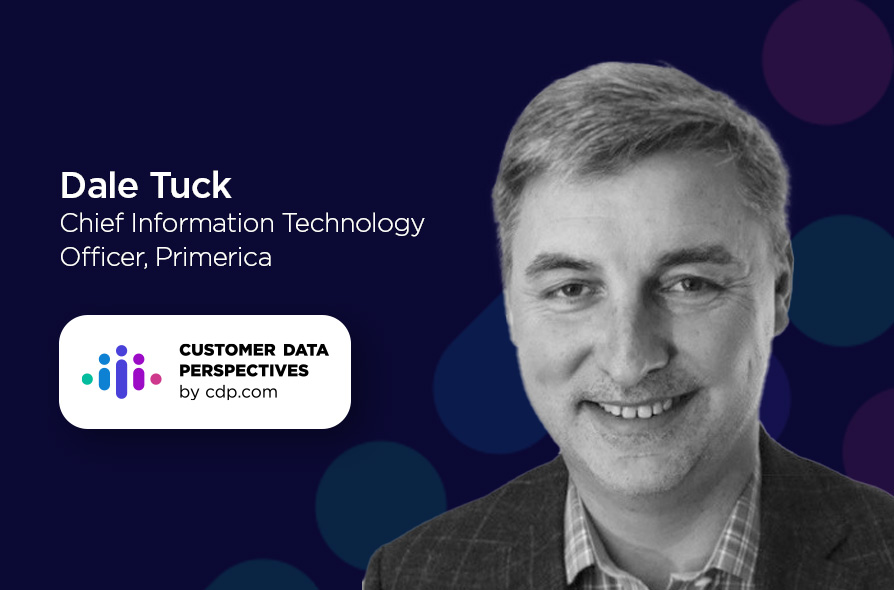“You can do that, right? That should be easy.”
Easy. The word every technology leader dreads hearing. On the face of it, many problems appear easy to solve with technology. But all too often, there’s more than meets the eye. And that’s especially true when working with customer data.
“I say there are very few easy data problems, there are lots of complex data problems – but they are all solvable.” Those are the wise words of Dale Tuck, Chief Information Technology Officer at Primerica, a publicly traded financial services company that provides insurance, investment, and financial services to middle-income families.
Tuck has spent his career in several data-rich environments solving data-centric problems. I recently sat down with Tuck to discuss the many ways he’s thinking about customer data for the Customer Data Perspectives podcast on CDP.com.
Click here to read the full transcript of the interview.
“The easy part of data is: It’s very easy to ignore it. That’s what a lot of people do,” Tuck continued, comparing data to bricks you might use to build a house.
“If you build a house, you want all your bricks to be neatly lined up. And as you’re building that wall, you want the bricks to be available. The bricks are like data. Sadly, in many organizations today, the bricks aren’t in a neat little pile – they’re spread all over the yard, they’re spread all over the neighborhood, they’re spread down the road. So it impedes your ability to build the house or the capability or to get the information you require.”
In our discussion, Tuck takes listeners through his advice on Customer Relationship Management (CRM) implementations, his belief on which data is most important, and how he’s thinking about hiring and retaining technology talent in these highly competitive times.
Do You Have a Vision for Your CRM?
Over the years, Tuck has been involved in several CRM implementations, including leading migrations from legacy systems to top-tier CRMs to greenfield projects. And if there’s one common theme that applies, no matter your implementation, Tuck says simply, “vision matters.”
Similar to how successful digital transformation initiatives start with requiring a business vision, Tuck says CRM implementations require the same.
“You have to bring a voice to the vision,” Tuck explains. “And that’s sometimes difficult because the vision of CRM is sometimes a little bit nebulous.”
So what does Tuck mean by a vision for a CRM? He explains that it goes beyond merely successfully installing a system.
“That should never be the goal of a CIO,” he said, adding that: “I know it is, but it should be: How does that system deliver the maximum value? Because the value will be remembered long after the missed deadline is forgotten.”
The Role of IT in Implementation
Tuck’s also a believer in having clear principles to guide any CRM implementation work. An example from Tuck’s career includes a CRM implementation that was laser-focused on “two clicks.” The vision was to ensure the new CRM would allow agents or sales reps to enable campaigns for their clients in two clicks. In the interview, Tuck elaborates on that example and underscores the importance of CIOs and IT leaders taking the time to fully understand data problems business leaders are trying to solve.
“It’s about being an asset to our business, and too often, IT is the order takers, and that’s the wrong place to be,” Tuck says.
Part of the IT leader’s role is to architect a solution with the appropriate tools for the job. CRMs are workflow tools for sales and marketing processes, and they capture data on accounts, contacts, marketing programs, and sales pipelines. But the enterprise has many systems of record collecting information about customers and prospects – the bricks in Tuck’s language. IT should review Customer Data Platform solutions that enable centralizing this data, developing insights, and using machine learning to personalize actions. CDPs provide different data capabilities than CRMs and other data management platforms (DMPs), and we reviewed these different platforms in a previous episode of customer data perspectives.
How A CITO Thinks About Data
Tuck’s passion for empowering teams with customer data shines through in all the compelling examples he shares during our discussion.
Among the areas Tuck is currently passionate about is using data and artificial intelligence (AI) to determine the “next best action” for customer engagement. Whether that’s actually making a sale or building a stronger relationship through personalization, Tuck says it’s a misnomer to assume all of your data is valuable. Instead, he says organizations need to identify their “strategic data assets” and put those to work.
“It’s not all of your data. It’s just pockets of that data that, when you append it and when you merge with other data, it starts to push you in the right direction,” Tuck says. “So data can help you do analytics and help you build better applications. But there’s kind of this third piece where it can start guiding you to what your next big business opportunity is going to be.”
Tuck also shares well-defined points of view on how organizations should be using customer data. Other topics you’ll hear Tuck talk about include why it’s so important for IT to ensure data is made available in a consumable way for business leaders, as well as the approach he’s taking to hire and retain great data talent. He even shares advice for vendors and partners who are pitching technology executives.
No matter where you sit in your organization, if customer data is on your mind, Tuck’s perspectives will get your gears turning about the art of the possible.



